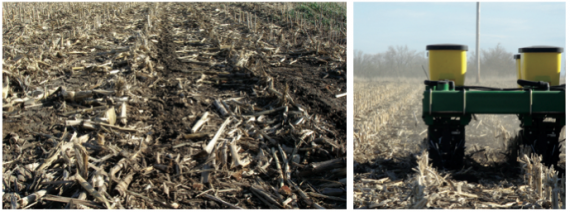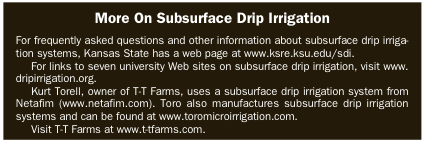Subsurface drip irrigation and no-till save water, time and money, while boosting corn, soybean and grain sorghum yields.
Nebraska no-tiller Kurt Torell readily volunteers that he didn’t like school. After graduating from high school in 1978, he began farming with his family.
But throughout his farm career, Torell’s been committed to lifelong learning on the job to farm more productively, conserve soil and water, and increase profitability.

90-FOOT PLANTER. Kurt Torell’s DB90 no-till planter has 36 rows on 30-inch spacings with three central fill seed hoppers. The planter allowed him to finish no- tilling corn and soybeans by May 5. He achieved a 7% yield increase over the previous year that paid for the planter.
That commitment and a quiet but seemingly insatiable curiosity led him to adopt no-till and innovative irrigation practices during the past 10 years.
Torell and his wife, Pamela, live on T-T Farms near Gresham, about an hour northwest of Lincoln, where they crop about 3,500 acres that are 90% to 95% irrigated.
They grow yellow corn, seed corn for Pioneer Hi-Bred, soybeans and some grain sorghum.
In the past decade, Torell has been working vigorously to perfect two systems: subsurface drip irrigation, starting in 2001, and no-till, beginning in 2003.
For Torell, irrigation and no-till are essential to success. He uses 21 center pivots on 2,660 acres and subsurface drip irrigation on about 600 acres.
Hates Wasting Water
Torell grew up using gated pipe irrigation, which he explains as water flowing in fields from gates in pipes down furrows and between ridges.
On flat fields, water from gated pipe may have a hard time making it all the way to the rows ends. Typically, the third of the field nearest the gates gets too much water, the middle third may have enough and the farthest third not enough. The system takes a lot of time and wastes water.
“We were running our tails off checking rows and changing gates,” Torell says, adding, “I just hated wasting water.”
In 1975, his family’s farm got its first pivot. Today, T-T Farms has 21.
“It’s not like we will ever get rid of them; they have their place,” he says.
But gated pipe and center pivot irrigation doesn’t work well on all fields. Pivots aren’t practical on fields with odd shapes.
Torell spent several years researching subsurface drip irrigation, which uses plastic driplines buried in fields to feed the crop’s root zone with filtered water and to inject nutrients.
Torell and his hired man started installing subsurface drip irrigation on the most difficult fields, finishing 248 acres in the spring of 2001. They buried the drip line parallel to rows, on 5-feet spacing, 16 inches deep.
That depth allows them to use a disc or a field harrow down to about 12 inches if they feel it’s necessary, but deep-ripping is out. Torell hastens to add that he doesn’t believe deep ripping is necessary to get water to infiltrate the soil.
They didn’t have RTK when they installed the first subsurface drip irrigation lines on the farm, Torell notes.
Today, using RTK when no-tilling corn allows him to plant 6 inches from the old row in continuous corn.
Happy Returns With Subsurface Irrigation
At $600 to $650 an acre, the price of materials for subsurface drip irrigation surprises inquisitive farmers.
“It’s expensive,” Torell says, “but it’s more than justified by the increase in productivity that occurs by saving water, energy and labor.”
But what stands out to Torell — what he calls the “biggest piece” of the system — is the increase in yields.
By using subsurface drip irrigation, farmers can spoon feed crops water when needed.
“You can give a piece of ground 2 to 3 shots of water a day,” which Torell says may total 0.15 to 0.2 inches. This reduces plant stress.
“You can inject fertilizer when it needs it, how it needs it,” says Torell, adding that using subsurface drip irrigation is like farming in a greenhouse. “We're able to apply greenhouse practices out in the field.”
Torell says he can feed the crop nitrogen, phosphorus, potassium and sulfuric acid with subsurface drip irrigation. Injecting sulfuric acid — a base — also keeps the tape’s openings, called emitters (tiny holes, like pores), clean and open.
Sulfuric acid also deters the 13-stripe ground squirrel and mice, which like chewing on the irrigation tape. In 2009, there were just eight to 12 leaks in 600 acres of subsurface drip irrigation.
Ground squirrels won’t dig if an area is wet. But a badger in pursuit of a rodent is “just like a posthole digger,” Torell says.
Leaks are easy to spot and fix by splicing. These problems are much easier to deal with than problems with a center pivot’s gearbox, when a pivot gets stuck or gets a flat tire.
No-Till Conserves Water
Torell farms in the Upper Big Blue Natural Resources District, which has the most irrigated land of any of the state’s natural resources districts. Irrigators must report how much water is used.
Each spring, the level of water in a number of test wells in the district gets measured. Mandatory restrictions on water use will start if the level drops too much, Torell says.
That means it’s important for irrigators to be proactive. Managing water use not only conserves the natural resource, but also controls the cost of pumping it.
Irrigators use diesel, natural gas, propane and electricity to power pumps.
In 2008, the cost of diesel was sky high and using electricity to pump water was the most economical.
No-tilling also reduces energy costs and conserves water in the soil.
With no-till, Torell applies burndown, plants, sprays post-emergence herbicides once or twice and then harvests. The farm’s fuel bill is nothing compared to what it once was with tillage.
“We don’t disc or use pre-plant tillage unless we have to,” he says, adding they occasionally use a shallow-set sweep when applying sidedress fertilizer on seed corn ground.
“No-till changed our farming practices in a big way,” Torell says. “It’s a win-win deal for us because yields are increasing, too. Our net return continually grows.
“We are making it work. We are really pleased.”
Torell started no-tilling in 2003 on dryland acres, then expanded it to irrigated ground and finally to the seed corn acres. Now he no-tills both soybeans and corn.
In 2009, the lowest soybean yields were 53 bushels per acre from a poorground, dryland field. The best bean yields were in the high 70s on irrigated ground.

Corn yields in 2009 ranged from a low of 155 bushels per acre on a dryland field in its sixth year of continuous corn to a high of 243 bushels per acre on irrigated ground.
Torell credits 6 years of no-tilling for improving the soil and allowing him to plant earlier.
“The ground has actually become much more friendly to supporting our equipment, allowing the planters to work that much better,” Torell says. “How you can have ground that is more firm and more mellow and at the same time more friable, that’s a soil structure thing. I don’t understand how it works, but it’s working.
“So we have been pushing our planting dates up more each year, going with bigger and heavier equipment. The soils have handled it well.”
His goal is to start planting by April 12 to 15; years ago, he aimed for April 20. But the last few springs have been too wet. In 2009, he couldn’t start until April 20.
Torell uses MT765 Cat Challengers equipped with Trimble’s RTK Autopilot and Ag Leader monitors. Designed for seed corn production, 45-foot-wide, stack-fold planter toolbars are set up for 18 rows on 30-inch spacings.
No-Tills Soybeans Sooner
In 2008, Torell bought a used DB90 planter. It’s 90 feet wide and has 36-row, 30-inch spacings. The planter has three central fill seed hoppers and blows seed to each row.
In 2009, Torell used the DB90 to no-till soybeans at the same time as they were no-tilling corn. Its high capacity enabled Torell to meet his goal of no- tilling all of the soybeans by May 5.
“Our yield increased a strong 7% over the previous year, and that paid for that planter,” Torell says.
For 2010, he’ll add Groff finger row cleaners to the DB90 to pull trash away from rows in fields that were in commercial corn or in seed corn and will be no-tilled to soybeans.

PRECISE PLANTING. Using Trimble’s RTK Autopilot and Ag Leader monitors, Kurt Torell is able to plant precisely just off the prior year’s corn rows to limit any residue management problems. He also plants corn as deep as 2.75 inches.
“It’s not like we are digging down in the dirt or removing root balls or anything like that,” Torell says.
The DB90 planter uses pneumatic down pressure, Keeton seed firmers and both a John Deere rubber press wheel and Dawn Curvetine for closing.
The corn planter has the same setup, except springs create the down pressure.
“You have to have good down pressure for planting corn. You’ve got to be heavy to hold those row units down where they need to be to cut through residue and have good seed-to-soil contact,” he says.
Plants Corn Deep
For corn, Torell’s definition of deep planting means 2.75 inches. He fields calls from neighbors at planting time who ask how deep he’s planting his corn. When he tells them 2.75 inches, they say, “You’re kidding! That will never come up.”
But it does, Torell says.
“It works. In these soils here in Nebraska, it works great.” Torell says.
The majority of the soil he farms is a heavy silt loam, which is a loess or wind-blown soil. It’s fairly level ground with pockets of silt-clay loam, which are either “powder fine like flour when dry or like cheese when wet,” he says.
Residue in no-till fields protects the surface from strong winds and helps maintain moisture in the soil.
Torell’s no-tills 36,000 seeds per acre on irrigated ground and 28,000 for dryland corn. He plans to increase populations on both by about 2,000 seeds per acre in 2010. For soybeans, he no-tills 180,000 seeds per acre.
Torell’s top priority when selecting corn and soybean seed, is yield, followed by a good disease package, good cold tolerance and early season vigor. He wants a seed that is a “good, strong pusher.”
After being absent for many years, Goss’ wilt has made a comeback in his area of Nebraska, Torell says. Goss’ wilt infects the corn plant’s leaves and can kill a large portion of the canopy, resulting in shutting down of the plant.
“It will knock off 30 bushels an acre or more. You can’t spray for it,” he says. “That makes good hybrid selection crucial.”
Takes Calculated Risks
Standability is also important for corn and soybeans, but Torell is willing to take a calculated risk.
In 2009, he planted 160 acres of corn on a center-pivot-irrigated field to a high-yielding, 115-day hybrid that doesn’t stand well. The corn was headed for a feedlot that wanted high-mois- ture corn.
Torell says he chose Pioneer’s 33Y74, a hybrid which he says puts all its energy into the ear and cannibalizes the stalk. But it yields well.

Torell says that when he told his dealer he wanted Pioneer 33Y74, the dealer warned it wouldn’t stand well.
Northwest winds of 40 mph hit the corn the day it was harvested.
“You could watch the corn fall over next to rows being combined,” Torell recalls.
The corn stalks were high enough for the combine to grab and the field yielded 239 bushels per acre.
In farming, Torell says, “Weather is No. 1.”





